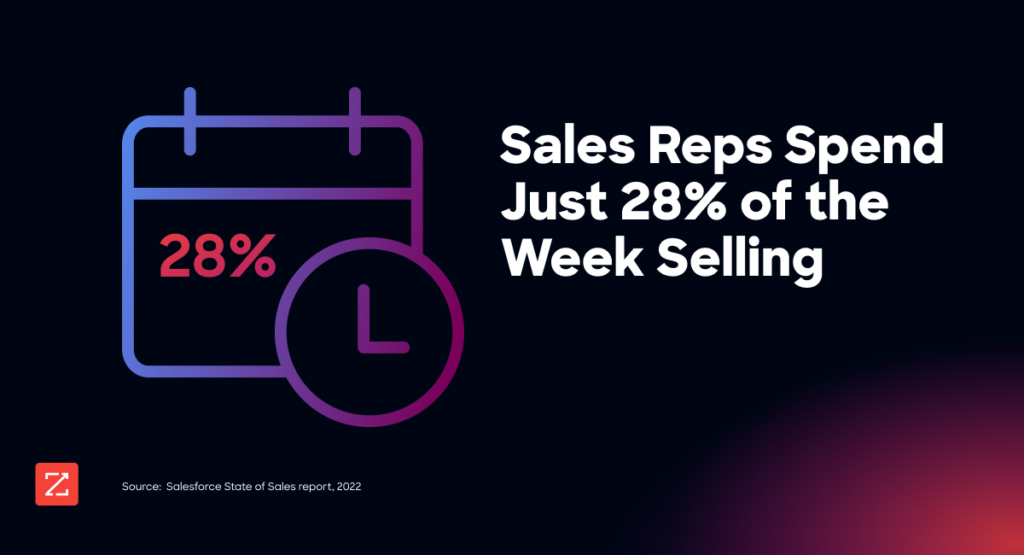Sales automation tools have the power to transform your go-to-market strategy, delivering better efficiency, quicker sales cycles and faster growth.
But in order to make the most of sales automation, sales reps, sales leaders, and revenue ops professionals have to get familiar with:
The basics of sales automation
How artificial intelligence strengthens automation
Why sales automation and modernization go hand-in-hand
The benefits of sales automation
How to roll automation into various stages of the sales process
Here’s how to connect those dots and deliver an automation strategy that can push your team to the next level, regardless of which way the economic winds are blowing.
What is Sales Automation?
Sales automation is the process of applying advanced software to reduce manual tasks in your sales motions.
A smooth sales process is a core business asset, establishing a specific flow for everyone to follow and making it easier to identify gaps that need improvement. Sales automation software helps build streamlined sales processes by taking on repetitive, simple tasks in order to free up time and energy for prospecting and nurturing leads.
Automation tools can run across a variety of platforms, including your CRM, email, and analytics apps.
Modernizing GTM — Why Sales Process Automation Matters
Today, building a modern go-to-market (GTM) playbook is a North Star metric for plenty of companies. And while the idea of highly optimized sales plays are not new, the combination of playbooks with advanced analysis and automation technologies can dramatically improve results for revenue teams of any size.
The benefits of automation are, at their core, about reclaiming time. Repeated surveys by Salesforce have shown consistently that sales professionals spend about two-thirds of their week doing things other than actually selling, a dramatic illustration of the bloat of administrative tasks that accompany most modern occupations.
Automation tools pull against this tide by relying on increasingly sophisticated machines to handle the mechanical tasks that suck up so much time — from smart integrations that seamlessly handle data and outreach coordination between apps, to advanced AI-powered apps that can draw from a sophisticated data asset to generate winning scripts and templates for busy sellers.
Overall, sales automation and the AI behind it enables sales teams and the rest of the GTM operations to focus more time on revenue-generating efforts and difference-making customer experiences.

How to Apply Sales Automation Across the Sales Process
Sales and revenue operations leaders have many options to choose from, allowing them to choose how much or how little of the sales process they want to automate. Some tools attempt to cover a large swath of the sales process while other tools are more specialized and focus on a few tasks, or just a single job.
Many modern CRMs have sales automations built in and may offer a marketplace of integrations to extend their functionality. Other tools, particularly from small companies, focus on automating a discrete portion of the sales process. This helps them nail one specific user experience but can reduce the likelihood that a major CRM or other key sales system will offer an integration.
If all of that sounds like a lot to get off the ground — you’re right. If you’re ready to power up a modern go-to-market program and need the full sales tech stack to match, ZoomInfo has all the functionality you need to optimize productivity, pipeline, and revenue.
Here are some of the most common tasks that can benefit from sales automation solutions.
Multi-Channel Prospecting
Your sales team would need to be massive — and expensive — to track and act on every single market signal that indicates a high-value lead is ready to move forward.
To make a team of any size more productive, consider ZoomInfo, which lets teams launch automated multi-step and multi-channel sales prospecting campaigns consisting of email sequences, calls, and reminders to connect via social media.
A/B test and tweak your campaigns to keep making your prospecting faster and smarter.
Lead Scoring
In a perfect world, 100% of our leads would convert. But in the real world, the process from top-of-funnel to conversion is much more complicated. This is why it’s critical to qualify each lead and implement a lead scoring methodology to remove subjectivity and ensure your sales reps are provided with actionable insights on qualified leads who have the greatest chance of converting.
Keeping track of individual lead activities and updating each score manually as they move through the sales funnel is a sure way to thwart your efforts in scaling up conversions.
So, don’t do it manually — invest in sales automation. Individual lead-scoring tools are actually hard to come by, as many CRM and sales and marketing automation platforms include this feature. So if this is an area where your sales team could use a little support, just be sure to add it to your check list when shopping for the other tools for your sales tech stack.
Phone Outreach
Phone outreach remains a bedrock of sales, no matter the market. But placing calls, “double tapping” key prospects, and leaving voicemails is just a time-consuming process. To win back some of that time, automate dialing with a sales dialer tool.
Some dialer tools even integrate with your CRM to prioritize the right prospects and increase call-to-connect rate — ZoomInfo, for example, integrates with the top CRM platforms and can leverage features such as ZoomInfo Intent and Sales contact profiles to dramatically increase the chances of converting leads.
Try a tool like RingCentral to automate parts of your phone outreach strategy, or look for this feature in a more robust, fully featured sales engagement and data platform.
Meeting Scheduling
Ever tried to get your family or friends together for a gathering? Between vacations and work and other plans, it can be downright painful. Trying to make those connections when deals are at stake makes the task even more daunting.
Time spent on back-and-forth email and phone exchanges takes time away from bottom-line sales activities and can easily make the prospect experience worse. There are a long list of apps that attempt to make scheduling across companies and systems less painful, including Calendly, or more open-ended webhook solutions, such as Zapier or IFTTT.
Patchwork solutions and single software tools, however, can only get your GTM team so far. If you’re ready to move beyond the basics, ZoomInfo’s sales workflow software can automate a galaxy of tedious outreach tasks, with the added benefit of direct connection to the industry’s most advanced GTM data asset, including real-time buying signals and unmatched contact data.
Email is a critical component of any lead generation and prospecting strategy. But understandably, many sales reps and account managers struggle to find time to create consistent, high-quality content at a cadence that generates real engagement.
Email automation makes it a lot easier to deliver welcome, nurture, free trial, and follow-up email campaigns to many people — yet still customize each of them based on the recipient’s preferences, behaviors, and interactions with your brand.
To ensure your sales emails don’t come off as hollow and impersonal, sales reps should A/B test various email templates to see what works best and define the message that resonates with their target audience.
Post-Sales Support
Some estimates indicate that 60% of customer support time is devoted to post-sales activities, including customer onboarding, up-sellling/cross-selling, and customer satisfaction campaigns that prevent churn.
It’s clear that customer support plays an important role in a modern go-to-market strategy. Bring your GTM up to speed by integrating customer success into your customer journey through customer support tooling.
There are several types of software in this space, which you can integrate based on your individual needs. Help desk software like Hiver is typically pivotal to customer support success, and other solutions include live chat, social listening, and customer feedback software.
And don’t forget the voice of the customer. ZoomInfo’s Chorus software can turn routine sales and support calls into priceless research and action items for the entire team with AI-generated post-meeting briefs that turn a call transcript into a memo highlighting the most important next steps, takeaways, and urgent areas of attention.
Benefits of Sales Automation Software
The upsides of investing in sales automation are plentiful — both for sales teams themselves and the people who lead them.
For Sales Leadership
You’ve felt the struggle — your sales team trying to keep up with data entry, quote generation, and other tasks that take them away from selling. And then there’s you, trying to keep on top of all the fresh strategies and daily assignments they need in order to be successful.
Automation is the perfect solution to help sales managers become better leaders. Automating aspects of the sales process allows sales leaders to keep better track of their teams, as well as helping them execute their actual jobs.
Let’s check out the key ways in which sales leaders can benefit from various forms of automation.
Effective Process Implementation
Every good sales process includes the strategic frameworks reps need to understand their work and the tactical levers they need to get the job done, including sales call scripts, talking points for overcoming sales objections, and upselling guidance.
With sales automation, you can integrate your sales playbook into sales reps’ workflows, ensuring that your sales team will be able to access and implement the right information for the right people, at the right time. After all, the more targeted and customized the sales approach, the more likely you are to land the deal.
Always-On Activity Capture
Activity capture tools boost sales productivity by keeping every salesperson’s email and calendar synced with your CRM. Using sales automation to handle this process enables sales self-starters to execute successful days and alleviates you from managing every single to-do item.
Quick Task Creation
Sales automation that recognizes hot leads and almost-closed deals can help you create all the tasks needed to focus your sales personnel on high-priority activities.
Automatically creating and assigning tasks based on priority saves you time while still keeping sales teams on their revenue-creating mission.
For Sales Teams
Your salesforce has a large number of daily responsibilities outside of selling, all of which impact your bottom line. Research, emailing back and forth, setting reminders, and tracking new lead activities all limit the time sales can spend reaching out to potential customers and making sales.
Optimizing efficiency across these jobs makes for more time selling as well as a more modern GTM approach — ultimately, increasing conversions and revenue.
Here are some core areas where sales automation directly impacts and improves the daily operations of your go-to-market strategy and improves your bottom line.
Optimized Efficiency
With the right pieces of automation software, sales reps can automate a huge portion of their outreach processes and follow-ups, and even have calls added to their schedule from within one platform. This makes for massively increased operational efficiency and higher close rates.
Faster Response Time
Response time is absolutely critical to successful lead conversion. This is where automation saves valuable time.
If a prospect shows real buying intent in your product or on your website, not only can a smart sales automation program automatically send the lead a message — it can also immediately notify the right sales rep to initiate seamless follow up.
Error-Free Record Creation
Sales automation can quickly generate new profiles in your CRM for leads who interact with your marketing materials — no manual input (or human error) required.
Storing and tracking their contact information, lead score, and behavior in your CRM where the whole GTM team can access it lays the foundation for more timely and accurate outreach.
Downsides of Sales Automation
So, does sales automation sound too good to be true?
As with any kind of technology, there are certain things to be wary of when it comes to automated workflows. Just because something can be automated, doesn’t mean it always should be — here are some of the reasons to be cautious about applying automation without a discerning eye.
Loss of Personal Feel
With any kind of automation, you risk losing the human touch. If you’re not careful, you could end up with outreach that sounds robotic, cold, and uninviting to the recipient. Avoid this at all costs, as personalization in the GTM strategy is a huge competitive differentiator.
Difficulty Integrating
Not every piece of sales automation software will be able to integrate with other tools, nor will it always work flawlessly within the sales tech stack you’re already using. Keep your IT requirements and technical savvy in mind to make sure you only select solutions that don’t create overlap and excessive data silos.
Costly Investment
Salespeople know that you can expect to pay for value, and there’s no question that the best sales automation suite will come with an investment. Make sure your company and GTM teams are on board with the organizational and behavioral changes this new investment will require in order to fire on all cylinders.
Where Will You Begin Your Automation and Modernization Journey?
Spending an inordinate amount of time on administrative work isn’t just boring for sales and GTM folks — it’s actively costing your business money.
Use this guide to implement sales automation and build out a modern GTM motion that maximizes team efficiency, allowing them to spend more time selling, closing leads, and increasing revenue. Ready to take your automation strategy further? Check out ZoomInfo’s GTM Plays, and see where we can help your business save time, increase sales, and create a modern, streamlined GTM motion that gets results.


